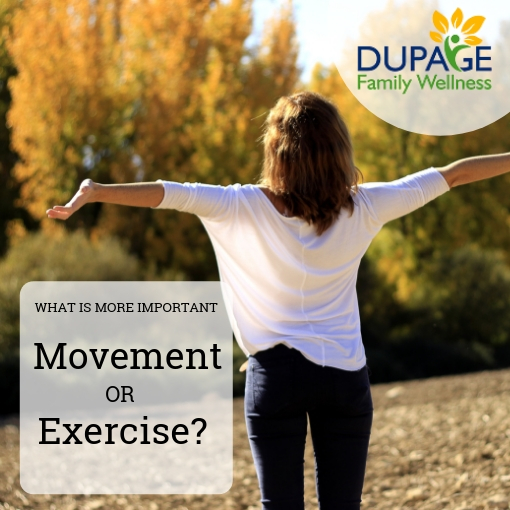Movement vs. Exercise
 Everyone knows that exercise is important! But what if I told you that I was more concerned about the level of movement in your life, than how much you exercise?
Everyone knows that exercise is important! But what if I told you that I was more concerned about the level of movement in your life, than how much you exercise?
I know, it’s shocking! Our culture is so focused on exercise that we forget the value of simply moving throughout the day. We think that we are living an active lifestyle if we go to the gym regularly, however if we are sitting the rest of our day we are still living a sedentary life.
The Danger of Sitting
According to Dr. James Levine, the director of the Mayo Clinic-Arizona State University Obesity Solutions Initiative, “Sitting is more dangerous than smoking, kills more people than HIV and is more treacherous than parachuting. We are sitting ourselves to death.”
What is even more surprising is that the negative effects of sitting are even apparent in those who exercise daily. We need to change our view of movement and find ways to incorporate natural movement into each part of our day!
Cavemen Didn't Exercise
When you think about the history of mankind, setting time aside to exercise is a fairly new concept. Movement was simply a part of life for most of our ancestors, as their survival depended on it. They didn’t need to go to a gym, because they moved to secure food, shelter, and safety!
This type of functional movement got their whole bodies moving in natural ways, and it was done in a natural environment! This is very different from the precise repetitive movements that most of our workouts at the gym include.
Are You Living in Captivity?
In the wild it is natural for orca whales to swim up to 100 miles a day while foraging for food. In captivity, this natural unrestricted movement is not possible. Instead of swimming through the ocean in an unrestricted manner, the captive orca spends it's days swimming in circles. This lack of natural movement is one reason that an orca’s fin will collapse while living in captivity.
As humans, when we restrict our movement due to work, busyness, or other lifestyle choices, we are like the captive orca swimming in circles. It’s like we have put ourselves into “captivity” without even realizing it!
Ways We Put Ourselves in Captivity
- Spending hours in one position (sitting in a chair at work or resting on a couch at home)
- Walking on flat ground
- Binding our feet in shoes (sometimes really unnatural shoes like high heels)
- Engaging in repetitive exercise
- Using machines that force our bodies into precise, yet unnatural movements (ellipticals, treadmills, etc.)
Human’s “Collapsed Fin”
While we do not have a fin that can collapse, humans do suffer from this captivity. For humans lack of natural movement may show up as:
- Knee pain
- Hip pain
- Collapsed arches
- Arthritis in your joints
- Tight hamstrings
- Leaky pelvic floors
- Bunions, etc.
Many patients tell me that they have “bad knees” or a “bad back”, but most of them never consider how it might have come to be that way in the first place. Most of the time we must look at the ways we have chosen to move (or not to move) our bodies, as well as the cumulative result of the stresses we have put (or not put) on our muscles, ligaments, tendons, and joints.
Ways To Incorporate Natural movement in Your Life
Our goal here is for long term changes, so it is okay to take things slow and steady. Our bodies are constantly adapting to what we ask them to do, so start small and work your way up. The most important thing to change is your mindset around movement!
- Walk somewhere instead of driving
- Sit on the floor or stand instead of reclining on a couch or a chair with a back
- Take a movement break at work
- Make a phone call while walking or have a walking meeting
- Skip using a convenient tool or food processor to prepare or chop something, and do it yourself with a knife
- Carry your child instead of using a stroller
- Use the basket instead of a grocery cart
- Water your plants with a pail instead of the hose
- Put on music and dance around your house instead of watching TV
- Take the stairs instead of the elevator
- Walk on an incline
- Try going barefoot
- Park further away at a store
Also, remember that movement doesn’t have to mean moving your body from one place to another. I would consider it “moving more” if your muscles are more engaged. For example, sitting on a stool would be moving more than lounging on a La-Z-Boy since your muscles will be more engaged to support your body.
A Lesson From the Children
We can also learn a lot about movement from the children around us! Children have fun with their movement, incorporating it into their daily lives in natural and spontaneous ways. In fact, sitting still is something they have to learn, because their natural inclination is to move!
Take some time to think about how often you move throughout your day as an adult. If your job requires you to sit for eight hours a day, are there ways to break it up? Remember that movement doesn't have to be strenuous! It could be as simple as walking to the water fountain, standing up for a phone call, or discretely stretching in your seat.
Let's learn from these little ones, and rediscover the joy that can be found in movement!

